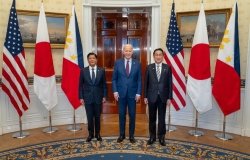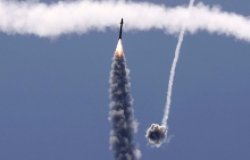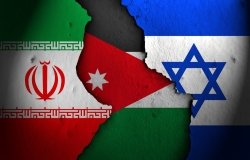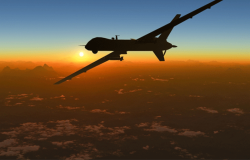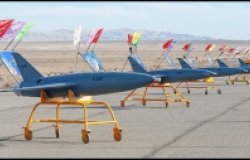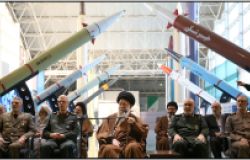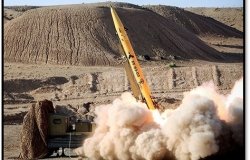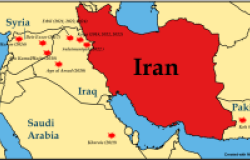The Iran Nuke Deal Could End Any Hope of Israeli-Palestinian Peace
"An agreement this complex will require interaction between the United States and Iran at many levels. To what extent that interaction, cooperation, and problem-solving (rather than problem-creating) will extend from the nuclear issue to regional issues is another matter," writes Aaron David Miller.
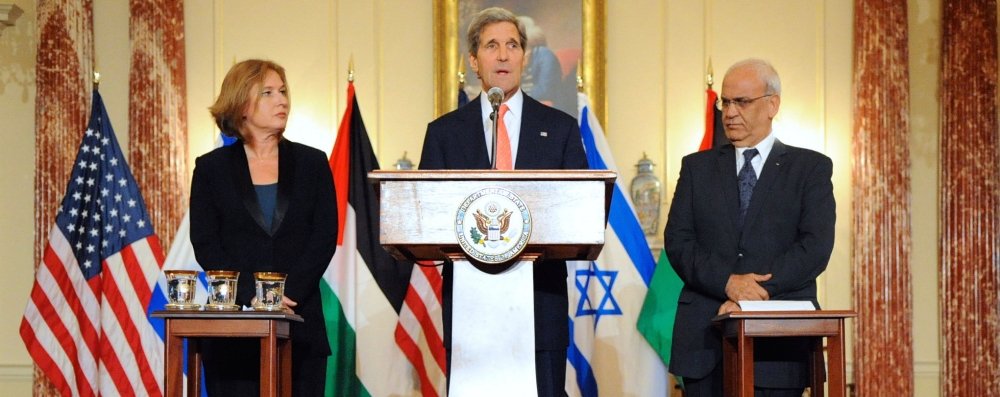
Whether you’re for the Joint Comprehensive Plan of Action (JCPOA), against it, or somewhere in between, the Iran nuclear agreement will have profound consequences for a Middle East already in the throes of turbulent change.
For 40 years, American policy toward Iran was based on the containment of Iran — at times even confrontation. That paradigm will now change. An agreement this complex will require interaction between the United States and Iran at many levels. To what extent that interaction, cooperation, and problem-solving (rather than problem-creating) will extend from the nuclear issue to regional issues is another matter.
And this uncertainty is why caution should be the order of the day. Indeed, as we’ve seen with other events in this region — notably the Arab Spring — change is not always positive, quickly apparent, or linear. “History, like nature, knows no jumps,” Robert Penn Warren wrote. “Except the jump backward, maybe.”
Time will be the ultimate arbiter of how this agreement will shape regional trends. And we should be careful not to make hard-and-fast predictions for a region that more often than not confounds rather than confirms experts’ views. But assuming the nuclear agreement reaches the implementation phase, here’s a first cut at seven regional trends that will likely be set into motion by one of the most portentous Middle Eastern events in decades.
Iran rising
Forget the old Arab Spring that lies in ruins. Pay attention to the new Persian one. And by “spring,” we’re not referring to dramatic political reform of the Islamic Republic. But happy days are here again for Iran nonetheless. As the Arab world melts down as a result of no governance (Syria, Libya, and Yemen) and bad governance (Iraq and Egypt), a highly functional, newly empowered, legitimized, and cash-flushed Iran will be rising. Indeed, the three most functional states in the region right now along with Arab Saudi Arabia are the three non-Arabs: Turkey, Israel, and Iran. All are stable with great economic potential and the capacity to project power. And at the moment, the JCPOA and the financial resources, economic recovery, power, and legitimacy it will bring suggest an Iranian moment.
More continuity than change — for now
Nothing will happen quickly. In the period ahead, the agreement needs to be sold and made normative (or not) in Washington and Tehran and at the United Nations. The International Atomic Energy Agency needs to validate Iran’s disclosures of its “possible military dimensions” by separate agreement and certify that Iran is complying with its commitments within the JCPOA. And then there’s sanctions relief, probably in early 2016.
How Iran seeks ultimately to use this opportunity is not yet entirely clear. The smart money would bet on more continuity than change. After all, Supreme Leader Ali Khamenei’s decision to approve the nuclear agreement wasn’t to undermine the hard-line, ideological, and revolutionary character of the regime or its support for its regional allies, but to conserve, preserve, and strengthen it. And at home, the key to that is to get out from under the kind of financial and economic pressures (in this case, crushing sanctions and isolation) that can make publics restless, alienated, and even revolutionary. Abroad, four decades of foreign policy based on resisting the United States, Israel, and Saudi Arabia isn’t going to change quickly, easily, or maybe at all. Remember that Iran’s founding ideology is one of countering “Westoxication,” with the constant suspicion of the “imperialist powers” that follows. Consider what the supreme leader said back in 2000:
An all-encompassing American plan has been arranged to collapse the Islamic Republican system, and all its aspects have been weighed. This plan is reconstructed from the collapse of the Soviet Union.… They have, in their own imaginings, revived the plan for the collapse of the Soviets in accordance with the conditions in Iran.
These bogeymen will help the regime marshal and mobilize its supporters and also continue to check reformists and pragmatists, like President Hassan Rouhani, who may get too strong. Speaking after the end of Ramadan, while praising his nuclear negotiating team’s efforts, the supreme leader made clear that any “dreams” that Iran and the United States would cooperate on other matters wouldn’t become reality, casting the United States’ actions in the region as “180 degrees” different from the Islamic Republic’s agenda. And the crowd responded with the usual cries: “Death to America” and “Death to Israel.”
The Iranians see the essence of the nuclear deal as merely transactional, not transformational — it buys time, resources, and a nuclear option for the mullahcracy.
Saudi Arabia and the Gulf: counterbalance?
In a dysfunctional Arab world, the only real regional counter to a rising Iran — and that isn’t saying all that much — is Saudi Arabia with a few Persian Gulf Arab states in tow. The Gulf states have different agendas vis-à-vis Tehran. Think Oman — the only Arab kingdom not to participate in the Saudi-led offensive against the Houthis in Yemen. And Oman, and even the United Arab Emirates, may well see benefits in testing the possibility of closer cooperation with Iran, particularly on the economic side. As evidenced by its tough (and so far unsuccessful) campaign in Yemen against the Houthis, Riyadh sees Tehran’s hand everywhere and fears that the nuclear agreement will only empower Iran further. Its checkbook diplomacy will continue to be used as a hedge against Iran.
Indeed, even before the accord, the Saudis had forged a reasonably common front with Turkey and Qatar to support Islamist fighters against President Bashar al-Assad in Syria. That coalition is likely to become more active.
Moreover, Saudi King Salman’s meeting with Hamas leaders last week would have been unthinkable a year ago and reflects the reality that Riyadh may be more open to aligning with Muslim Brotherhood types to counter Iran and its Shiite allies. Saudi Arabia is demonstrating new assertiveness and in the process a new independence from the United States too. Much of the tension in the U.S.-Saudi relationship flows from Riyadh’s conviction — much like Israel’s — that U.S. President Barack Obama’s administration is naive about Iran and not nearly forceful enough in countering Iran’s allies, such as Assad. The United States may try to reassure the Saudis with arms sales, intelligence sharing, and closer cooperation. But until the Saudis believe that Washington understands the Iranian challenge and is prepared to do something about it, the strain will remain.
Syria, Iraq, and Yemen: proxies, not progress
And that strain is driven primarily by Iran’s behavior (or misbehavior) in the region. Or what Saudi Foreign Minister Adel bin Ahmed al-Jubeir calls Iran’s “adventures.” The problem of course is that Tehran — even though its allies (Hezbollah, Iraqi Shiite militias, and Assad) are overextended and comprise pretty weak tea — has managed to hold its own and become the dominant regional power in Iraq and Syria. In Yemen, by providing relatively low-cost support to the Houthis, Iran has managed to bog the Saudis down in an unwinnable air campaign and blacken their image as their airstrikes claim civilian lives. And an infusion of even 10 to 20 percent of the $100 billion in expected unfrozen oil revenue next year would be useful in bucking up Iran’s allies. Financial and economic support for what’s left of the Syrian regime is critically important to Assad’s survival, as are the Shiite Iraqi militias, Hezbollah, and Iranian Revolutionary Guards, which are in Syria shoring up the regime. It’s no coincidence that Assad welcomed the nuclear accord, which he sees as producing a cash windfall — some of which may be coming his way.
There’s little doubt that Iran and the United States — and the Saudis too — have a common stake in checking the Islamic State’s further gains in Iraq and even in Syria. And since tacit cooperation was established before the nuclear agreement, it’s likely to continue on that front. Iraqi Prime Minister Haider al-Abadi welcomed the nuclear accord because he sees the easing of U.S.-Iranian tensions as creating a better front against the Islamic State. Other Sunni leaders aren’t so sure and worry that Iran’s newfound power would mean stronger Shiite militias at their expense. And there is a view that the threat of the Islamic State does make Iraqi Shiites more dependent on and beholden to Tehran. Bottom line: If there’s one area that seems hopeful in terms of U.S.-Iranian cooperation, it’s the fight against Sunni jihadis.
The key question of course is Syria and under what circumstances would Iran consider changing course and cooperating with the United States to bring about a new reality there. We wonder whether this is even a relevant question now? Syria and Iran have been allies now for four decades, and while Assad has been an increasing drain on Tehran, Iran needs an Alawite stronghold in Syria to avoid encirclement by Sunnis — both Saudis and the Islamic State — and to preserve the connection to Lebanon and Hezbollah. And the last thing the supreme leader can afford now on the heels of a U.S.-Iranian agreement is to signal that Iran is abandoning its allies and cooperating with the “arrogant” Americans. In fact, just this month in the midst of the nuclear talks, Syria ratified a $1 billion line of credit from the Islamic Republic to buck up its fledgling economy. Iran is likely to try to keep an Alawite enclave in Syria viable as long as possible until a new balance of forces on the ground either undermines Iran’s position in Syria or secures it. And eager to sell billions of dollars in arms to Iran and to prevent a jihadi takeover in Syria, Russia will back up Iran’s support of Assad. Bottom line: Don’t look for much Iranian help on Syria anytime soon.
A frustrated Israel
Some Israelis have made the case that the nuclear deal carries one large advantage for Israel: the key decision point at which Iran would get the bomb and Israel would have to bomb has been put off, perhaps by a decade. But the majority of those in the political elite, particularly Prime Minister Benjamin Netanyahu, have reacted vociferously against the agreement. The argument is that the agreement will not stop Iran’s nuclear weapons clock and that lifting sanctions will only fuel Iran’s regional misbehavior.
And for Netanyahu, the issue is deeply personal. He has been focused on Iran for decades. Not being able to prevent the accord, given the risks he took, is something of a political defeat. But more than that he now has a continuing mission to keep on opposing the deal. But he has very limited options. Israel will have no more success lobbying Congress this time around than it did in January. There’s no possibility of a military strike against Iran’s nuclear sites in the wake of an agreement — if successfully implemented. Nor will the United States support Israeli cyberattacks and assassinating Iranian scientists if the Iranians are holding up their end of the bargain. Nor do the Israelis have many good options against Iran’s allies. Indeed, with Hezbollah bogged down in Syria, the chances of a serious Israeli-Hezbollah clash are reduced.
More than likely, unless Iran violates the agreement in some major way, Israel will have no choice but to work closely with the United States on intelligence sharing to monitor the accord and to see what the Americans are prepared to offer Israel in the security field in return. But none of that is going to substantially improve the U.S. president’s relationship with the Israeli prime minister. The Obama-Netanyahu relationship is already a dysfunctional one. And the upset over how the Iran nuclear deal played out is only going to make matters worse. Bottom line: The next 15 months will be as rocky as the previous period and could even reach a new low.
Peace process: one more nail
One issue that could help drag the U.S.-Israel relationship down is the peace process or, more accurately, the absence of one. There are enough nails in this coffin already: big gaps on the core issues between Israel and the Palestinians and between the United States and Israel, the Palestinian decision to take Israel to the International Criminal Court, splits between Hamas and Fatah, and an Israeli government that has neither the will nor the capacity to take this issue on.
But fearing violence on the ground and looking for some idea that will stabilize the situation for the remainder of its term and also leave a legacy, the Obama administration has been considering some kind of framework on Palestinian statehood. This could take the shape of either a U.N. Security Council resolution — already a favorite project of the French (complete with a draft) — or a U.S.-initiated set of parameters that would be designed to reaffirm the feasibility and desirability of a two-state solution, including the key elements necessary to make it work. Neither could actually trigger a serious negotiation under the current circumstances, let alone produce an agreement, and it’s by no means certain that the Palestinians would sign on. One thing is certain: Such an exercise is bound to increase tensions between the United States and Israel. More than likely for the remainder of Obama’s term, the peace process will be shaped by a two-state solution that’s too hard to implement but too important to abandon.
U.S. policy
So how will the Obama administration choose to spend its last 18 months in the Middle East? Will it choose to test the possibility of cooperating with Iran in Syria, Yemen, and Iraq? Will we see Secretary of State John Kerry in Tehran within a year, particularly if Iran frees the Americans it’s holding and provides information on the one it claims it doesn’t have? Or will the U.S. president take the advice of some of Iran’s critics and signal to Iran that the United States is going to push back against Iran’s regional misbehavior and work aggressively to weaken Assad and push for a political solution? Our bet is neither one. Faced with tremendous uncertainty in a region that’s out of control, the president will likely try to secure the single accomplishment he has: making sure the Iran nuclear agreement is implemented. That will be tough enough. As for keeping busy until 2017, we kind of figure an unpredictable Middle East will take care of that.
The opinions expressed here are solely those of the author.
This article was originally published in Foreign Policy.
About the Author


Middle East Program
The Wilson Center’s Middle East Program serves as a crucial resource for the policymaking community and beyond, providing analyses and research that helps inform US foreign policymaking, stimulates public debate, and expands knowledge about issues in the wider Middle East and North Africa (MENA) region. Read more
